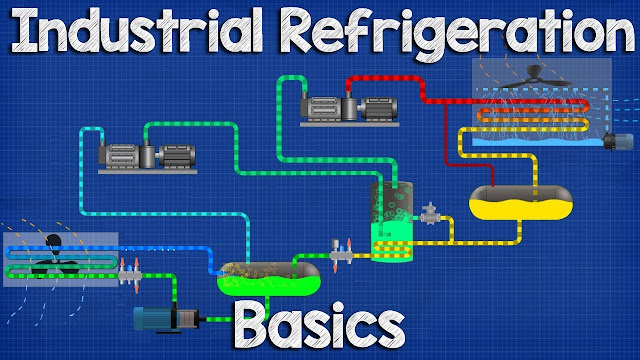 |
| Industrial Refrigeration system Basics - Ammonia refrigeration working principle |
The term refrigeration means cooling a space, substance or system to lower and/or maintain its temperature below the ambient one (while the removed heat is rejected at a higher temperature). In other words, refrigeration is artificial (human-made) cooling. Energy in the form of heat is removed from a low-temperature reservoir and transferred to a high-temperature reservoir.
The work of energy transfer is traditionally driven by mechanical means, but can also be driven by heat, magnetism, electricity, laser, or other means. Refrigeration has many applications, including household refrigerators, industrial freezers, cryogenics, and air conditioning. Heat pumps may use the heat output of the refrigeration process, and also may be designed to be reversible, but are otherwise similar to air conditioning units.
Refrigeration has had a large impact on industry, lifestyle, agriculture, and settlement patterns. The idea of preserving food dates back to at least the ancient Roman and Chinese empires. However, mechanical refrigeration technology has rapidly evolved in the last century, from ice harvesting to temperature-controlled rail cars.
The introduction of refrigerated rail cars contributed to the westward expansion of the United States, allowing settlement in areas that were not on main transport channels such as rivers, harbors, or valley trails. Settlements were also developing in infertile parts of the country, filled with newly discovered natural resources.
These new settlement patterns sparked the building of large cities which are able to thrive in areas that were otherwise thought to be inhospitable, such as Houston, Texas, and Las Vegas, Nevada. In most developed countries, cities are heavily dependent upon refrigeration in supermarkets in order to obtain their food for daily consumption.
The increase in food sources has led to a larger concentration of agricultural sales coming from a smaller percentage of farms. Farms today have a much larger output per person in comparison to the late 1800s. This has resulted in new food sources available to entire populations, which has had a large impact on the nutrition of society.
As quite similar criteria shall be fulfilled by working fluids (refrigerants) applied to heat pumps, refrigeration, and organic Rankine cycles; several working fluids are applied by these technologies. Ammonia was one of the first refrigerants. Refrigeration can be defined as "The science of providing and maintaining temperature below that of surrounding atmosphere". It is the continuous extraction of heat from a body.
Industrial refrigeration system basics, in this video we'll be looking at how ammonia refrigeration systems work, starting at the basics to understand how industrial refrigeration systems work. We'll be looking at system schematics and animations to build your refrigeration knowledge. We cover why we use ammonia, where we use industrial refrigeration, single stage systems, two stage systems and cascade systems.
Related topics:

Post a Comment